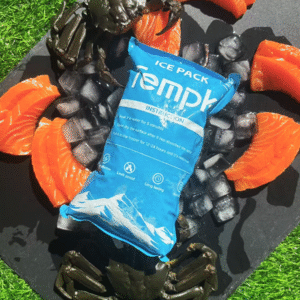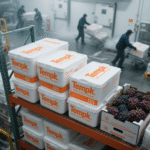Dry Ice Packaging Requirements for 2025: A Comprehensive Guide
In 2025, the logistics of shipping temperature-sensitive products like pharmaceuticals, biologics, and food demand precise dry ice packaging compliance. Dry ice, which sublimates at -78.5°C, plays a critical role in cold chain logistics by maintaining required low temperatures without the risk of melting. However, its handling is tightly regulated. This guide provides a detailed breakdown of the updated dry ice packaging requirements for 2025, ensuring your shipments stay safe, compliant, and efficient.
-
What are the key dry ice packaging requirements for 2025?
-
How to ensure compliance with UN1845 and PI 954?
-
What impact do 2025 regulations have on dry ice packaging?
-
How to prevent common mistakes in dry ice packaging?
-
What are the best practices for packing dry ice safely and efficiently?
What Are the Key Dry Ice Packaging Requirements for 2025?
In 2025, dry ice packaging regulations are guided primarily by the IATA Packing Instruction 954 (PI 954) and UN1845, ensuring safety and proper labeling. Key requirements include:
-
Venting: Packages must allow the escape of CO₂ gas to prevent pressure buildup.
-
Proper Labeling: Every shipment needs to be clearly labeled with the UN1845 number, the weight of the dry ice, and a Class 9 hazard symbol.
-
Packaging Materials: Use strong, insulated materials that permit safe sublimation of CO₂ gas. Suitable options include Styrofoam coolers and plastic-lined boxes.
-
Weight Limit: Air shipments are restricted to 200 kg of dry ice per package.
Real-world Example:
A global pharmaceutical company enhanced its dry ice packaging compliance by rigorously following PI 954 and UN1845 guidelines, ensuring flawless audits and timely delivery of temperature-sensitive products.
How Do I Pack Dry Ice for 2025 Compliance?
Packing dry ice correctly in 2025 requires adherence to multiple safety and regulatory standards:
Step-by-Step Packing Process
-
Choose Insulated Containers: Use materials like Styrofoam or plastic coolers. These must be capable of withstanding the extreme cold of dry ice without compromising safety.
-
Venting: Ensure containers are vented to allow CO₂ gas to escape, preventing pressure buildup.
-
Dry Ice Placement: Position the dry ice on top of the shipment. As dry ice is heavier than air, placing it on top helps maintain the correct temperature for sensitive products.
-
Sealing and Labeling: Ensure the container is sealed but vented, and label it with UN1845, Class 9 symbols, and the net weight of the dry ice.
Best Practices
-
Weight Verification: Double-check that the total dry ice weight does not exceed the 200 kg limit for air shipments.
-
Use IATA’s Checklist: Regularly follow the IATA checklist to ensure compliance with all safety standards and documentation requirements.
| Requirement | Details | Implications for You |
|---|---|---|
| UN1845 Label | “Carbon dioxide, solid (dry ice)” | Ensures shipment identification and regulatory compliance |
| Vented Packaging | Proper venting for CO₂ gas release | Prevents rupture and ensures safety |
| Weight Limit | 200 kg per package for air transport | Avoids non-compliance and shipment delays |
| Documentation | Accurate net weight and shipper details | Essential for audits and customs clearance |
How Do New 2025 Regulations Impact Dry Ice Packaging?
The 2025 regulations introduce stricter safety and compliance protocols, including updates to IATA PI 954 and the DGR (Dangerous Goods Regulations). The most significant changes include:
-
Enhanced Venting Regulations: More stringent requirements for CO₂ gas escape to prevent dangerous pressure buildup inside the containers.
-
Digital Air Waybills (eAWB): Increasingly adopted worldwide, eAWBs will require more precise tracking and documentation of shipments.
-
Temperature Monitoring: Certain shipments, especially pharmaceuticals and biologics, now require real-time temperature monitoring to ensure product integrity during transit.
Key Changes to Note:
-
eAWB Adoption: Mandatory in more regions by 2025, improving efficiency and compliance.
-
Pressure Testing: Stricter packaging pressure testing guidelines to withstand the release of CO₂ gas.
-
Regulatory Updates: Some regions have introduced tighter restrictions on CO₂ venting to prevent unsafe buildup.
Common Mistakes in Dry Ice Packaging and How to Avoid Them
Dry ice packaging errors can lead to shipment delays, compliance issues, or even damage to sensitive products. Here are the most common mistakes and how to avoid them:
-
Improper Ventilation: Failing to vent packages allows CO₂ gas to accumulate, which can cause the package to rupture. Always ensure packaging allows gas to escape.
-
Incorrect Labeling: Missing or incorrect UN1845 labels can delay shipments or lead to fines. Verify that all labels are applied correctly.
-
Overloading the Package: Exceeding the 200 kg weight limit can lead to non-compliance. Stick to the specified weight limits.
-
Inadequate Packaging Material: Using unapproved or damaged packaging can cause temperature fluctuations. Only use materials that meet the required standards.
Key Trends in Dry Ice Packaging for 2025 and Beyond
As we look towards the future of dry ice packaging, key trends indicate a shift toward sustainability, automation, and technology integration.
-
Sustainability Initiatives: Companies are moving towards biodegradable packaging and reusable shippers to reduce environmental impact.
-
Automation in Cold Chain Logistics: Smart sensors are becoming a standard feature in dry ice packaging, enabling automated temperature and gas monitoring.
-
Innovative Packaging Solutions: New materials that extend the cooling duration of dry ice shipments are being introduced, optimizing product safety.
2025 Trends and Future Developments in Dry Ice Packaging
With the global demand for temperature-sensitive products growing, especially in pharmaceuticals and biotech, the dry ice packaging industry is seeing significant developments. Innovations include IoT monitoring systems for real-time temperature data and the rise of portable dry ice generators to minimize transportation costs.
-
Market Growth: The dry ice packaging market is expected to grow significantly as the demand for biologics, vaccines, and frozen food rises. Analysts predict a 7.6% annual growth rate from 2025 to 2032.
-
Sustainable Packaging Solutions: The trend toward using recyclable and biodegradable materials is accelerating, driven by both consumer demand and regulatory pressures.
FAQ: Dry Ice Packaging Requirements
Q1: What is the maximum weight of dry ice allowed per package for air shipments?
A: Up to 200 kg of dry ice per package is allowed for air shipments under IATA regulations.
Q2: Can I reuse my dry ice packaging materials?
A: Yes, reusable packaging materials are permitted, but they must be inspected for structural integrity and cleanliness before reuse.
Q3: How can I prevent pressure buildup in my dry ice shipment?
A: Use vented packaging that allows CO₂ gas to escape and avoid sealing seams completely to prevent pressure buildup.
Conclusion and Recommendations
To ensure compliance with dry ice packaging requirements in 2025, it is crucial to follow the latest regulations and best practices. Focus on proper ventilation, accurate labeling, and using the right packaging materials. Regularly train your team on updated SOPs and stay informed about regulatory changes.
Next Steps:
-
Review and update your dry ice packaging SOPs to meet 2025 standards.
-
Invest in sustainable packaging solutions to minimize environmental impact.
-
Implement real-time temperature monitoring for sensitive shipments.
About Tempk
At Tempk, we specialize in providing compliant dry ice packaging solutions that ensure the safe transport of your temperature-sensitive goods. Our materials meet all IATA and UN1845 requirements, ensuring that your shipments are safe, compliant, and efficient.
Ready to ensure your shipments are compliant? Contact us today for personalized guidance.
























